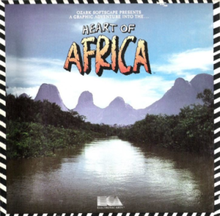
M.U.L.E. is a multiplayer video game written for Atari 8-bit computers by Ozark Softscape. Designer Danielle Bunten Berry takes advantage of the four joystick ports of the Atari 400 and 800 to allow four-player simultaneous play. Published in 1983, M.U.L.E. was one of the first five games from new company Electronic Arts, alongside Axis Assassin, Archon: The Light and the Dark, Worms?, and Hard Hat Mack. It is primarily a turn-based strategy game, but incorporates real-time elements where players compete directly as well as aspects that simulate economics.
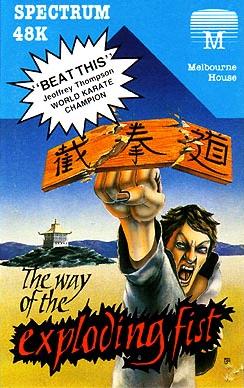
The Way of the Exploding Fist is a 1985 fighting game based on Japanese martial arts developed by Beam Software, by a team consisting of Gregg Barnett, Bruce Bayley, Neil Brennan and David Johnston. Originally developed on the Commodore 64 and published in June 1985 by Melbourne House, ports were made for Amstrad CPC, ZX Spectrum, BBC Micro, Acorn Electron and Commodore 16.

Spy vs. Spy is a video game written by Michael Riedel for the Commodore 64 and published by First Star Software in 1984. A port for the Atari 8-bit computers was released simultaneously. It is a two-player, split-screen game, based on Mad magazine's long-running cartoon strip Spy vs. Spy, about the slapstick antics of two spies trying to kill each other with improbably elaborate traps and weapons.

Mail Order Monsters is an action-strategy computer game created by Paul Reiche III, Evan Robinson, and Nicky Robinson. It was published by Electronic Arts for the Commodore 64 in 1985, then released for Atari 8-bit computers in 1986. Players create monsters which they can use to battle multiplayer or against computer-controlled opponents.
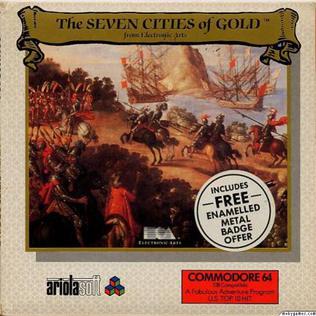
The Seven Cities of Gold is a strategy video game created by Danielle Bunten Berry and Ozark Softscape and published by Electronic Arts in 1984. The player takes the role of a late 15th-century explorer for the Spanish Empire, setting sail to the New World in order to explore the map and interact with the natives in order to win gold and please the Spanish court. The name derives from the "seven cities" of Quivira and Cíbola that were said to be located somewhere in the Southwest United States. It is considered to be one of the earliest open world video games.

Autoduel is a role-playing video game published by Origin Systems for the Atari 8-bit computers, Commodore 64, Apple II, and IBM PC compatibles in 1985. It was released in 1987 for the Atari ST and in 1988 for the Amiga and Macintosh. The game is based on the Steve Jackson Games series Car Wars.

Beyond Castle Wolfenstein is a 1984 World War II stealth game. A direct sequel to Castle Wolfenstein, it is the second game in the Wolfenstein series, and the last installment to be released by original developer Muse Software before the name was revived for a first-person shooter in 1991. Castle Wolfenstein was written solely by Silas Warner for the Apple II, while the sequel was developed simultaneously for the Apple II and Commodore 64 by Warner, Eric Ace, and Frank Svoboda III. It was quickly ported to the Atari 8-bit computers and MS-DOS.

Theatre Europe is a turn-based strategy video game developed and published by Personal Software Services (PSS). It was first released in the United Kingdom for the Commodore 64, ZX Spectrum, Amstrad CPC, and Atari 8-bit computers in 1985. It was later released in France by ERE Informatique in 1986, and was released in the United States by Datasoft later that year. A port for the Tatung Einstein was released in 1989, in the UK. It is the fifth installment of the Strategic Wargames series.

Ace of Aces is a combat flight simulation game developed by Artech Digital Entertainment and published in 1986 by Accolade in North America and U.S. Gold in Europe. It was released for the Amstrad CPC, Atari 8-bit computers, Atari 7800, Commodore 64, MSX, MS-DOS, Master System, and ZX Spectrum. Set in World War II, the player flies a RAF Mosquito long range fighter-bomber equipped with rockets, bombs and a cannon. Missions include destroying German fighter planes, bombers, V-1 flying bombs, U-boats, and trains. In 1988, Atari Corporation released a version on cartridge for Atari 8-bit computers styled for the then-new Atari XEGS.

Patton vs. Rommel is a computer wargame designed and programmed by Chris Crawford for the Macintosh and published by Electronic Arts in 1986. Versions for MS-DOS compatible operating systems and Commodore 64 were developed by Sculptured Software and published in 1987.
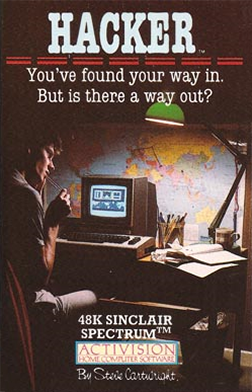
Hacker is a 1985 video game by Activision. It was designed by Steve Cartwright and released for the Amiga, Amstrad CPC, Apple II, Atari 8-bit computers, Atari ST, Commodore 64, Macintosh, MS-DOS, MSX2, and ZX Spectrum.

Crossfire is a multidirectional shooter created by Jay Sullivan for the Apple II and published by On-Line Systems in 1981. Using keyboard-based twin-stick shooter controls, the player maneuvers a ship in a grid-like maze. Versions with joystick-control use the stick for movement and switch to firing mode when the button is held down.

Destroyer is a naval combat simulation video game published by Epyx in 1986 for the Amiga, Apple II, Commodore 64, and IBM PC compatibles.

Battle of Britain is a turn-based strategy video game developed and published by Personal Software Services for the Commodore 64 in 1985. It was also ported to the Amstrad CPC and ZX Spectrum the next year. It is the seventh instalment to the Strategic Wargames series. The game is set during the Battle of Britain campaign of the Second World War and revolves around Britain's defence and prevention against a Nazi invasion. In the game, the player commands the Royal Air Force as they must defend key cities against the Luftwaffe.

Superman: The Game is a 1985 video game designed by Fernando Herrera and published in the US by First Star Software for the Commodore 64. For European release, Superman was ported the Acorn Electron, Amstrad CPC, Atari 8-bit computers, BBC Micro, and ZX Spectrum.

The Pharaoh's Curse is a platform adventure game written by Steve Coleman and published by Synapse Software in 1983 for Atari 8-bit computers. It was ported to the Commodore 64 and VIC-20, with the VIC version published by Human Engineered Software. Coleman also wrote Rainbow Walker for Synapse, published the same year.

Dragonriders of Pern is a video game published by Epyx in 1983 based on Anne McCaffrey's book series of the same name. The game was released for the Atari 8-bit computers and Commodore 64.

Lode Runner's Rescue is a 1985 action game developed by Joshua Scholar for the Commodore 64 and Atari 8-bit computers as a follow-up to Doug Smiths's Lode Runner. Lode Runner was published by Broderbund, but the sequel was published under the Synapse Software name, a company acquired by Broderbund in 1984. Lode Runner's Rescue uses isometric projection to give a 3D feel.

Gumball is a video game written for the Apple II by Veda Hlubinka-Cook and published by Broderbund in 1983. It was ported to the Atari 8-bit computers, and Commodore 64. The player controls the valves of a maze-like machine to sort gumballs by color.
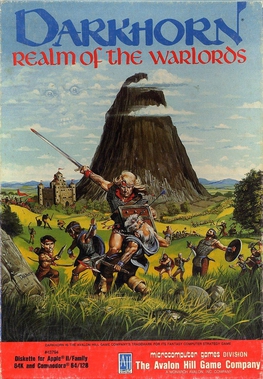
Darkhorn: Realm of the Warlords is a computer wargame published in 1985 for the Apple II and Commodore 64 by Avalon Hill.
